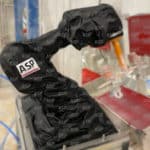ATEX is the abbreviation for “Explosive Atmosphere”. The ATEX directive exists to regulate aspects of explosion protection in the European Union, with both an operational directive and a product directive. The ATEX-compliant robot cover is designed to prevent the ignition of potentially explosive and hazardous atmospheres.
As a manufacturer of protective covers for robots, ASP develops, invents and produces various technologies to provide optimum protection for industrial robots. The ATEX robot protective cover, which is made of TATEX fabric (polyester fabric coated on one side), is a high-tech protection solution made with special materials in accordance with the ATEX product directive 2014/34/UE.
ASP manufactures custom-made protective covers for all common robot brands (KUKA, FANUC, ABB, Yaskawa etc.) and protects industrial robots (articulated arm robots, palletizing robots, 6-axis robots, welding gun robots, etc.) in various application areas, environments, and industries. ATEX covers (or EX protection covers) are used, for example, in the automotive industry, metal processing, and paint application.






